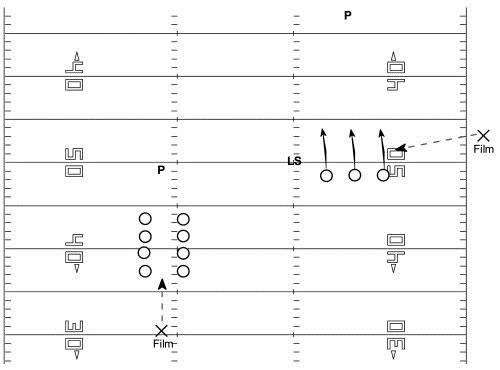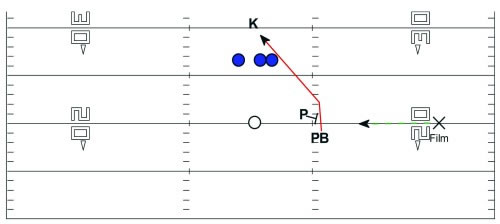| Put the Block On – Block circuit drills and
chances of blocking a punt. By: Robby Case Provided by: American Football Monthly
Blocking punts takes not only personal belief and courage, but training and a good scheme to get the right player free to the punter. We teach the techniques necessary to properly block punts. We also practice different drills to train players to use those techniques plus a few scheme adjustments to try to get players free to the punter. I always tell the players that I want volunteers, not mercenaries. Mercenaries are people you hire to do a job; volunteers do it because they love it. Punt Block Philosophy The only time we use the term punt “return” is when we are referring to the opposing team. We always speak to our guys about our punt “block” team. We try to set that mindset from our first meeting and make it very clear we are going to come after almost every punt we see. As a side note, I name every special teams unit to try to give them their own separate identity. The punt block unit is named the “Sharks.” When the Sharks are on the field, they smell blood in the water and attack on every snap. So why block punts instead of return them? I have found that with the wide-spread popularity of the shield punt formation, returning punts has become increasingly difficult. For example, our opposing punt return teams in 2013 averaged only 3.48 yards a return on 28 opportunities. The advantage of the shield punt is that it allows players to get out and cover faster than the traditional kick slide punt. Shield punts also make it easier for coverage players to get into their coverage landmarks and create a net around the returner. The shield punt formation is one reason why we feel we have a better chance in affecting the outcome of the game by attacking the punter before he gets the kick off. The second reason we go for the block is that I have found that most punters at the Division II level, and even at the FBS level, are erratic with their hang time and distance, which makes setting up a return and then getting it started difficult. These two reasons, plus lacking an explosive punt returner, have lead us to attack every punt we face. By having a block mentality, you can affect the punt team without having to block every punt. The opposing punt team is alerted all week by their coach that they have to protect, before cover, and the specialists have to have a fast operating time. It puts pressure on long snappers and punters to be perfect. Also, specialists tend to shy away from pressure situations. This can lead to bad snaps or rushed kicks that are shanked. On the occasion when you do decide to set up a return, the cover team takes longer to get out because they are told all week they must protect longer to stop the rush, which then neutralizes one of the advantages the shield punt provides. To make this philosophy effective, you must commit to it. You have to train players to properly block punts and find the right guys who have the courage and belief to execute the techniques. Punt Block Techniques The hesitation many coaches have about attacking the punt is the fear of a roughing the punter penalty. This is why you have to train your players through drill work to properly block punts and respect the punters’ halo. We teach our players to NEVER leave their feet. Accelerate past the punter to avoid falling on his legs. At the block point, cross your hands one over the other to avoid the hands opening and missing the ball. Reach down and take the ball off the foot of the punter. You go up to block field goals and down to block punts. See the ball kicked by looking through your crossed hands and don’t blink or you’ll miss your opportunity. For inside rushers, do not cross the punters face with your rush angle. Rather, reach across your body with your hands and clear your hips. For outside rushers, set an angle five yards in front of the punter or ten yards from the ball and let the punter come to you. The following are just a few drills we use to teach punt block techniques. Punt Block Drills Block Circuit (Diagram 1). We like to utilize a circuit to teach the different phases of the punt block. The first station is the “trigger” phase. The trigger phase is the initial get off. Rushers must dip their shoulder to take away their surface to punch and then rip through the block so they don’t get knocked off their track to the punt. The fastest route from point A to point B is a straight line and to block a punt, you must have great speed to the block point. The trigger phase is critical to getting to the block point with a quick time. Have a long snapper give the rusher a trigger key. You can also incorporate another player to cross the ball with a hand shield to give the rusher a defender to dip and rip off of.
The final station is the actual block point. Players form two lines, five yards from a punter. They run one at a time on a proper block angle and work on accelerating past the punter while incorporating the proper block techniques with their hands and eyes. The punter should have a large bag of balls and a number of people helping him shag balls that are blocked. The punter is critical to this drill. He must use consistent timing to get the rushers in a rhythm. 1-on-1 Punt Rush (Diagram 2). This drill consists of one punt player vs. one punt block player. The punt block player has 2.0 seconds to get to the 10 yard block point. We have a long snapper give a trigger key. We place three pop up bags at seven yards to simulate a shield. The punt block player must execute all three phases of the punt block to get to the block point in 2.0 seconds. This drill also trains the players on your punt team. They must take their two steps and strike to get the rusher off of his rush line and prevent him from getting to the block point in 2.0 seconds and then cover past the line of scrimmage. This teaching point is important; most players on the punt team forget to cover after they strike. Either have a punter hold a ball off of his foot at 10 yards or have a ball on a stand as a target block point for the player rushing the punt. Make the punt team work on front and backside blocking techniques.
Punt Block Scheme Adjustments The first question you have to answer when creating a blocking scheme is can you get four players free to the shield? Most shield schemes will cut three players loose for the shield to block so the key is how you can get one additional rusher through cleanly. Scouting an opponent’s punt team and understanding their protection tendencies are critical. The backside of a directional protection is the most difficult to protect, so if you can get a beat on their directional protection, try to attack the backside B gap. Every player on our punt block team uses a three-point stance, which shows a block demeanor. We also use pre-snap movements to try to confuse punt teams into protection errors. For example, we start in a balanced block and shift late in their cadence to an overload. We also stack our four interior rushers in a straight line and break them late to a balanced or overloaded alignment (Diagram 3).
|









